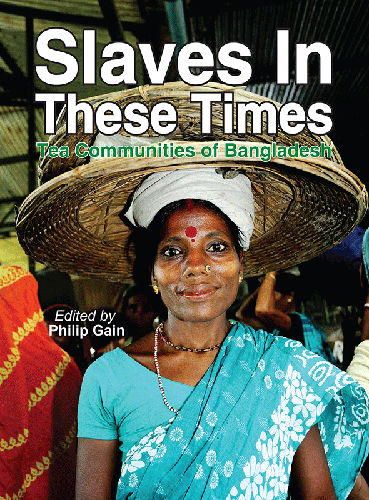
Slaves In These Times: Tea Communities of Bangladesh
‘Slaves In These Times: Tea Communities of Bangladesh’ focuses particularly on the communities found in the tea gardens of the Northeast and Southeast of Bangladesh. SEHD has found as many as 80 communities in 156 tea gardens in Sylhet, Habiganj, Moulvibazar, Chattogram and Rangamati districts. Of these communities, 23 are mentioned in the official list contained in Khudra Nri-Gosthi Sangskritik Pratisthan Ain, 2010 (last revised in 2019). The other communities [including Bengalis) in the tea gardens belong to different ethnic identities.
Edited by Philip Gain | English, PBK 396 pages, 2016 | Price: Taka 600, US$15
 This book includes profiles of all of 80 communities showing the diversity of ethnic identities that make each tea garden a territory largely unknown to the people of the majority community. One special feature is each profile contains a portrait, a geographic map and a table that shows the number of tea gardens, the upazilas and districts they live in. Originally, these communities lived in Bihar, Madras, Orissa, Andhra Pradesh, Madhya Pradesh, West Bengal, Uttar Pradesh and other places in India. The British companies had begun to bring them to work in the tea gardens in Sylhet region more than 150 years ago. One striking fact about the tea workers is that they remain largely unknown to the majority people of Bangladesh. The tea workers are indeed citizens of Bangladesh, but they remain tied to the tea gardens and the labour lines and fall behind as equal citizens.
This book includes profiles of all of 80 communities showing the diversity of ethnic identities that make each tea garden a territory largely unknown to the people of the majority community. One special feature is each profile contains a portrait, a geographic map and a table that shows the number of tea gardens, the upazilas and districts they live in. Originally, these communities lived in Bihar, Madras, Orissa, Andhra Pradesh, Madhya Pradesh, West Bengal, Uttar Pradesh and other places in India. The British companies had begun to bring them to work in the tea gardens in Sylhet region more than 150 years ago. One striking fact about the tea workers is that they remain largely unknown to the majority people of Bangladesh. The tea workers are indeed citizens of Bangladesh, but they remain tied to the tea gardens and the labour lines and fall behind as equal citizens.
In addition to the profiles of the tea communities that live in the tea gardens, a large section of the book is devoted to general overview of the tea industry, brief profiles of all tea gardens; investigative reports that explain the contexts of their deprivation and alienation; useful tips on web resources and institution on tea communities and tea industry; glossary, concepts and theories related to the tea communities and the tea industry and geographic maps of the tea gardens (district-wise and the whole country).
The key message that the texts of this book communicates is that the tea workers and their communities are one of the most marginalised and vulnerable peoples in Bangladesh. They continue to remain socially excluded, low-paid, deprived of standard education and disconnected. They have also lost their original languages in most part as well as their culture, history, education, knowledge and unity. It is in this context that they deserve recognition of their identities and special attention from the state, not just equal treatment.
One consulting this volume, together with the volume on the marginalised ethnic communities of Bangladesh concentrated in Northwest and North-centre and the photography volume on all ethnic communities, will get a comprehensive map of the ethnic and tea communities in Bangladesh.
Edited by Philip Gain
English, PBK 396 pages, 2016
Price: Taka 600, US$15
